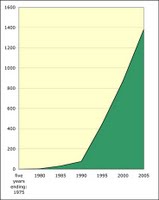Parmigiano Reggiano Redux
Thursday, October 1, 2009"The undisputed king of cheeses." Mario Batali
Several years ago, as I emerged from the airport in Naples and stepped for the first time onto an Italian street, I saw, just a few yards away, my first Italian billboard. It said, simply -- and, I thought, eloquently -- "Parmigiano Reggiano." "Now this," I thought, "is a civilized country; a place that has all its values in place." Naples is a long way from Parma -- and while Italy is a country of regional foods (so much so that foods from a nearby village are often considered to be "foreign "), Parmigiano Reggiano can be found everywhere.
Without doubt, Parmigiano Reggiano is a wonderful cheese. It has had that reputation in Italy for nearly 800 years (even if that name didn't yet exist). Boccaccio's Decameron -- written in the mid-fourteenth century -- describes Bengodi, a mythical happy valley, not unlike the valleys in which Parmigiano Reggiano is produced, where:
"...they bind the vines with sausages, and a denier will buy a goose and a gosling into the bargain; and on a mountain, all of grated Parmesan cheese, dwell folk that do nought else but make macaroni and ravioli, and boil them in capon's broth, and then throw them down to be scrambled for; and hard by flows a rivulet of Vernaccia, the best that ever was drunk, and never a drop of water therein."
Boccaccio's little culinary flourish -- cooking pasta in capon broth -- has a Bolognese refinement about it. Today's Bolognese cooking is still reminiscent of that described by Boccaccio -- although, tomatoes from the New World (not available in Boccaccio's time) are required to make the famous Ragu Bolognese.
The quality of Parmigiano Reggiano is no accident. After it is produced and aged for one year, it is inspected by a battitore (expert cheese taster), and sorted into three grades. Two that meet the Consorzio's quality standards can be called Parmigiano Reggiano after the fire-brand certification mark is applied. The third is cheese that doesn't meet the standards and is declassified. It can only be labeled as ordinary grana, and is reserved for industrial uses, such as the manufacture of processed foods. Of the two certified qualities of Parmigiano Reggiano, Mezzano is best eaten young, before eighteen months and Classico is aged for an additional six to twelve months. Very little Mezzano is sold in the US, 'though it less expensive. Some Classico, after additional inspections, can achieve a top-of-class certification and is marked "extra" or "export" ('though the latter term is gradually being phased out).
Rob Kaufelt, the proprietor of Murray's Cheese Shop -- in New York City's Greenwich Village -- says that Parmigiano Reggiano is one of his three top-selling cheeses (along with Brie and "the entire Cheddar family"). Granted, Kaufelt's customers are among the most educated consumers of cheese, but a craving for Parmigiano Reggiano has been awakened in average American consumers as well -- people who have, only in the past decade or so, learned that grated cheese can be much more than that dried-out powder on the counter in pizza parlors.
Silvestro Silvestori, who runs a cooking school in Lecce, Italy -- Awaiting Table -- has noticed that many of his American students "pride themselves on only using Parmigiano Reggiano." One would think that Italians, if given the choice, would abandon all other hard grating cheeses (such as Grana Padano -- which also comes from the Po Valley, its name means "Grana from the Po Valley" -- and Pecorino Romano) for this one cheese from the Emilia Romagna.
Italians do not restrict themselves to Parmigiano Reggiano anymore than Indians eat only curries, or all Mexican foods contain chiles The notion is so simplistic that it borders on the ridiculous -- and this from people who pride themselves on their gourmet bona-fides (whether they actually possess them or not).
Certainly, it was only a matter of time before a great cheese, like Parmigiano Reggiano, was "discovered" by American foodies -- and once discovered, it's not at all surprising that its fame spread in food-loving circles. The only question, then, is how did Americans first learn that it was so much more than the pre-grated stuff they were used to getting at the grocery store? Those of us who live in areas where great imported foods, and high-quality ingredients, are easy to find, may be disappointed when traveling to remote regions. I recently searched, in vain, for Parmigiano Reggiano in a large grocery store in upstate New York. When I asked an employee, I was directed to the dried pasta aisle where the store's only grated cheese sat on a shelf -- and, just like the powdery substance of the 1950s, it apparently had no need of refrigeration. No doubt the green foil was all the protection it needed.
In 1979, Burton Wolf spent two weeks at Marcella Hazan's cooking school in Bologna -- trying to assemble "a checklist of Italian cooking equipment." When he came back, he wrote up his findings for an article in the Washington Post (August 12, 1979). One of the items on that list was a cheese gouger, the sturdy dagger-like blade used for breaking off ragged chunks of hard cheeses. Along with his description of the cheese gouger, he wrote, casually,
"One of the most commonly used cheeses in Italian cooking is Parmigiano Reggiano, and it's very hard."
It was the earliest mention that I've been able to find, in US print media (using Lexis-Nexis, that only goes back to 1970), of the "undisputed king of cheeses." Waverley Root had written an article about the cheese for The International Herald Tribune six years earlier, and Business Week had mentioned the cheese in a 1969 article, but more Americans would have read their first account of Parmigiano Reggiano in Wolf's article. Given its centuries-old existence in Italy, it's not surprising that it was "commonly used" there, but that it took average American cooks (unlike the sophisticated customers of Murray's Cheese) so long to place it on its culinary throne is odd.
Serious cooks, the kind that would have sought out cookbooks by Marcella Hazan, would have known, as she wrote in 1973, that "There is no more magnificent table cheese than a piece of aged, genuine parmigiano reggiano, when it has not been allowed to dry out and it is a glistening, pale straw color." However, average American cooks would have had little exposure to the name in main-stream media. The following graph shows the number of articles mentioning Parmigiano Reggiano -- as found in a Lexis-Nexis search -- in US magazines, journals, and major newspapers.
Obviously, something happened shortly after 1990. A little background information, about the years leading up to that 1990-2005 surge, might help here.
In 1955, the name "Parmigiano Reggiano" was formally registered in Italian law, and defined both by time of year (originally, between April first and November eleventh – but, since 1984, year-round) and the provinces in which it could be produced (according to the Consorzio del Formaggio Parmigiano-Reggiano, "Parmigiano Reggiano is strictly bound to its place of origin. Both the production of milk and its transformation into cheese take place in the provinces of Parma, Reggio Emilia, Modena, Bologna to the west of the Reno River and Mantua to the east of the Po River."). It merged the old names "Parmigiano" and "Reggiano," eliminating any distinction between the two cheeses. The quality of Parmigiano Reggiano is maintained and protected, for the last 75 years, by a group of local producers: the Consorzio del Formaggio Parmigiano-Reggiano (known, before 1955, as the Voluntary Interprovince Consortium between producers of typical grana).
One of the reasons the cheese's popularity has grown, well beyond the relatively small number of serious foodies was because of a small but very successful food-marketing campaign, and the establishment -- in 1986 -- of a US Information Office to promote American awareness of the cheese. Building on two decades of references in cookbooks, an effort was made to reach Americans through the consumer press (by bringing a few select journalists to Italy each fall), and its success is reflected in the graph.
The timing was fortuitous, as Americans were becoming food-conscious on a scale that had never existed before (the term "gourmet," which had suggested elitism, was about to be replaced by "foodie" -- which was much more casual, and could be assumed by anyone without fear of appearing pompous).
Having educated us to recognize Parmigiano Reggiano as the apotheosis of cheeses, the consortium is fighting a great battle to protect its status. First, the name itself has to be protected: unfortunately, in the US, "parmesan" is incorrectly used on domestically-produced hard grating cheese with no connection to the original cheese coming from the area around Parma. Second, Germany has, for some time, been producing cheeses they call "parmesan" that were meant to confuse consumers and cut into Parmigiano Reggiano's market (the European Union has protected the name "Parmigiano Reggiano" since 1996, and ruled in February 2008 that only cheeses made in Italy can be called "parmesan" (on the grounds that "parmesan" is only a translation of "Parmigiano Reggiano"). The situation is similar to that of "Champagne," which, in Europe refers to sparkling wine onlyfrom a specific region of France, but is a meaningless commercial term in the US). Third, at least one big American company is pushing to lower the standards for production of domestic "parmesan." In 2005, Kraft petitioned the FDA to reduce the required aging period from ten to six months (by Italian law, Parmigiano Reggiano must be aged a minimum of twelve months; in addition, the "extra" certified cheeses are marked by red, silver and gold seals, that are aged, respectively, for 18, 22, and 30 months).
The consorzio that has protected Parmigiana Reggiano for so long has its work cut out -- but it's good work in service of a great cheese. It's serious business -- but it's also got a lighter side. If you don't believe me, just pay a visit to their delightful advertising campaign site: Pubblicita completa Parmigiano Reggiano.
Be warned, however: once you've been there, you will annoy all your friends and relatives by singing -- or attempting to sing -- its irresistible jingle for weeks afterwards.
References and Acknowledgements
For much of the information in this article, I am directly indebted to Cara De Silva, and to Nancy Radke, Director of the US Information Office of the Consorzio del Formaggio Parmigiano-Reggiano.
Boccaccio, Giovanni. The Decameron (Rigg, J. M., trans.), Volume II
"EU Court Says Parmesan Cheese Must Come From Italy."
Huffington, Ariana. "Cheese-gate: On the Trail of Phony Formaggio." The Huffington Post,
"Petition to Amend Standards for Parmesan and Reggiano Cheese."
Wolf, Burton. "Untitled." The Washington Post (August 12, 1979, Sunday, Final Edition), G1.




0 Comments:
Post a Comment
Subscribe to Post Comments [Atom]